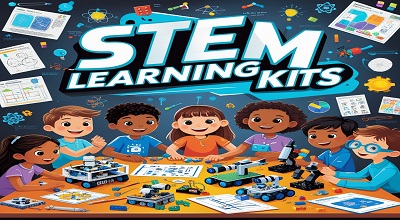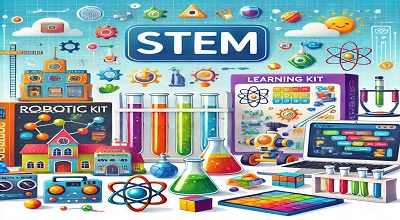STEM Learning Kits
STEM education, which stands for Science, Technology, Engineering, and Mathematics, has gained significant traction in recent years as a vital component of modern education. One of the most engaging ways to introduce these subjects to learners of all ages is through STEM learning kits. These kits provide hands-on experiences that foster curiosity, creativity, and critical thinking. In this article, we will explore what STEM learning kits are, their benefits, various types, and some popular examples.
What are STEM Learning Kits?
STEM learning kits are educational tools designed to teach concepts in science, technology, engineering, and mathematics through interactive and hands-on activities. These kits often include materials, instructions, and sometimes digital resources that allow learners to engage in experiments, build projects, or solve problems. The primary goal of these kits is to make learning fun and accessible while promoting essential skills such as problem-solving, teamwork, and analytical thinking.
The Importance of STEM Education
STEM education is crucial for preparing students for the future workforce. As technology continues to evolve, the demand for skilled professionals in STEM fields is increasing. By introducing students to STEM concepts early on, we can help them develop a strong foundation that will serve them well in their academic and professional careers. Furthermore, STEM education encourages innovation and creativity, which are essential for addressing the complex challenges of the modern world.
Benefits of STEM Learning Kits
STEM learning kits offer numerous benefits for learners, educators, and parents alike. Here are some of the key advantages:
1. Hands-On Learning
STEM kits provide a tactile learning experience that engages students in a way that traditional classroom methods may not. By working with physical materials, learners can better understand abstract concepts and see the real-world applications of what they are studying.
2. Encouragement of Critical Thinking
Many STEM kits require students to solve problems, make decisions, and think critically about their approach. This process helps develop essential skills that are applicable in various aspects of life.
3. Fostering Creativity
STEM learning kits often encourage creativity by allowing students to design and build their projects. This freedom to explore and innovate can lead to a deeper understanding of the subject matter.
4. Collaboration and Teamwork
Many STEM kits are designed for group activities, promoting collaboration among students. Working together on projects helps develop communication skills and teaches the value of teamwork.
5. Adaptability for Different Learning Styles
STEM kits can cater to various learning styles, making them suitable for a diverse range of students. Whether a learner is visual, auditory, or kinesthetic, there are kits available that can meet their needs.
Types of STEM L – Kits
STEM learning kits come in various forms, each focusing on different aspects of science, technology, engineering, and mathematics. Here are some common types:
1. Science Kits
These kits often include experiments related to biology, chemistry, physics, and earth science. They may contain materials for conducting experiments, such as chemical reactions, plant growth, or physics demonstrations.
2. Technology Kits
Technology kits focus on coding, robotics, and electronics. They often include components for building circuits, programming robots, or creating apps. These kits help students develop digital literacy and technical skills.
3. Engineering Kits
Engineering kits encourage students to design and build structures or machines. They may include materials for constructing bridges, towers, or vehicles, allowing learners to explore concepts such as force, balance, and design principles.
4. Mathematics Kits
Mathematics kits often incorporate games and puzzles that promote mathematical thinking and problem-solving. They may include activities related to geometry, algebra, or statistics, making math engaging and fun.
5. Integrated STEM Kits
These kits combine elements from all four STEM disciplines, providing a comprehensive learning experience. They may involve projects that require scientific inquiry, technological application, engineering design, and mathematical reasoning.
Popular Examples of STEM Learning Kits
Here are some popular STEM learning kits that exemplify the diversity and engagement these tools can offer:
1. Snap Circuits
Snap Circuits are electronics exploration kits that allow students to build various electronic projects using snap-together components. With over 100 projects available, learners can experiment with circuits, lights, and sounds, making it an excellent introduction to electronics.
2. LEGO Mindstorms
LEGO Mindstorms combines the creativity of LEGO building with robotics. Students can design and program their robots using a user-friendly interface, fostering skills in engineering, coding, and problem-solving.
3. Thames & Kosmos Chemistry Kits
These kits provide hands-on experiments in chemistry, allowing students to conduct safe and exciting experiments at home. They cover various topics, from basic chemical reactions to more advanced concepts, making chemistry accessible and engaging.
4. Osmo Genius Starter Kit
The Osmo Genius Starter Kit combines physical play with digital learning. It includes games that teach math, spelling, and problem-solving skills through interactive activities that use a tablet and physical game pieces.
5. Kano Computer Kit
The Kano Computer Kit allows students to build their own computer and learn coding through fun projects. It promotes digital literacy and technical skills while encouraging creativity and exploration.
6. GoldieBlox Engineering Kits
GoldieBlox kits are designed specifically for girls, promoting engineering and problem-solving skills through storytelling and hands-on building activities. These kits aim to inspire young girls to pursue STEM fields.
7. LittleBits Electronics Kits
LittleBits kits consist of modular electronic components that snap together to create various projects. They encourage creativity and innovation while teaching the basics of electronics and engineering.
How to Choose the Right STEM Learning Kit
When selecting a STEM learning kit, consider the following factors:
1. Age Appropriateness
Ensure the kit is suitable for the learner’s age and skill level. Some kits are designed for younger children, while others may be more appropriate for older students or adults.
2. Learning Objectives
Identify the specific skills or concepts you want to focus on. Choose a kit that aligns with those objectives, whether it’s coding, engineering, or scientific inquiry.
3. Interests of the Learner
Consider the interests of the learner. A kit that aligns with their passions will be more engaging and motivating.
4. Quality and Reviews
Research the quality of the kit and read reviews from other users. High-quality kits will provide a better learning experience and are more likely to withstand repeated use.
5. Budget
STEM kits can vary significantly in price. Determine your budget and look for kits that offer the best value for your investment.
Integrating STEM Learning Kits into Education
Educators can effectively integrate STEM learning kits into their curriculum by following these strategies:
1. Project-Based Learning
Incorporate STEM kits into project-based learning activities, allowing students to explore real-world problems and develop solutions using the kits.
2. Collaborative Learning
Encourage group work and collaboration by assigning projects that require teamwork. This approach fosters communication skills and enhances the learning experience.
3. Cross-Disciplinary Connections
Connect STEM learning kits to other subjects, such as art or social studies, to create a more integrated learning experience. For example, students can design a historical structure using engineering principles.
4. Assessment and Reflection
Use assessments to evaluate students’ understanding of the concepts learned through the kits. Encourage reflection on their experiences and what they learned during the process.
FAQs about STEM Learning Kits
1. What age group are STEM learning kits suitable for?
STEM learning kits are available for a wide range of age groups, from toddlers to adults. It’s essential to choose a kit that matches the learner’s age and skill level.
2. Are STEM learning kits expensive?
The price of STEM kits can vary significantly. While some kits are budget-friendly, others may be more expensive due to the complexity of the materials and projects. It’s essential to find a kit that fits your budget.
3. Can STEM learning kits be used at home?
Yes, many STEM learning kits are designed for home use and can be an excellent way for parents to engage their children in educational activities outside of school.
4. Do STEM kits require adult supervision?
Some STEM kits may require adult supervision, especially for younger children or projects involving potentially hazardous materials. Always read the instructions and safety guidelines provided with the kit.
5. How do STEM kits promote critical thinking?
STEM learning kits often involve problem-solving and decision-making tasks that require learners to think critically about their approach and solutions, fostering essential skills for future challenges.
6. Are there STEM kits specifically for girls?
Yes, there are STEM kits designed specifically for girls, such as GoldieBlox kits, which aim to inspire young girls to pursue interests in engineering and technology.
7. Can STEM kits be used in classrooms?
Absolutely! STEM learning kits can be effectively integrated into classroom settings, promoting hands-on learning and collaboration among students.
Conclusion
STEM learning kits are an invaluable resource for educators, parents, and learners alike. By providing hands-on experiences that engage students in science, technology, engineering, and mathematics, these kits foster critical thinking, creativity, and collaboration. With a wide variety of kits available, there is something for everyone, making STEM education accessible and enjoyable for all. As we continue to embrace the importance of STEM in our society, investing in these learning tools will undoubtedly help shape the innovators and problem-solvers of tomorrow.

